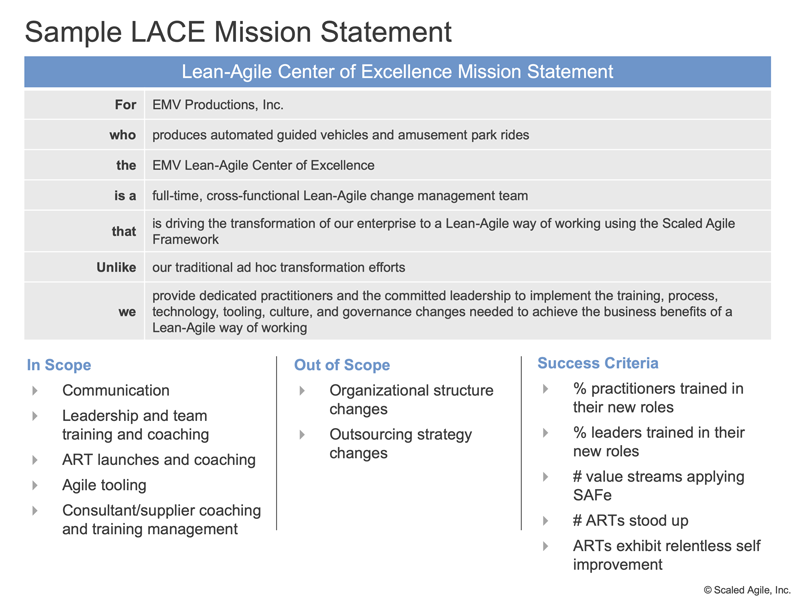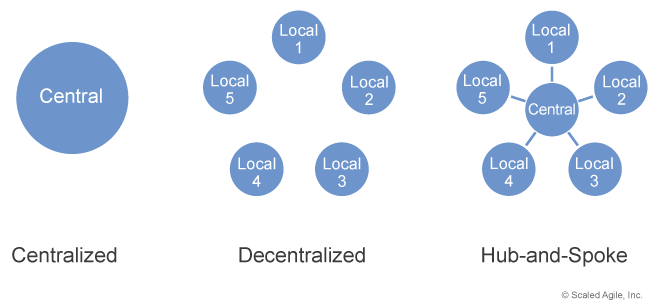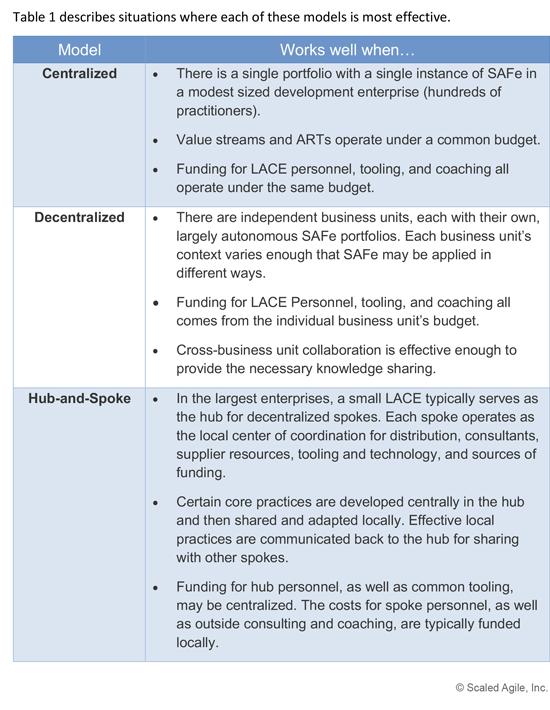A guiding coalition that operates as an effective team can process more information, more quickly. It can also speed the implementation of new approaches because powerful people are truly informed and committed to key decisions.
—John Kotter
Create a Lean-Agile Center of Excellence
This is article four in the SAFe® Implementation Roadmap series. Click here to view the entire roadmap.
The Lean-Agile Center of Excellence (LACE) is a small team of people dedicated to implementing the SAFe Lean-Agile way of working. Creating a LACE is often one of the key differentiators between companies practicing Agile in name only and those fully committed to adopting Lean-Agile practices and getting the best business outcomes. The LACE is the third element of the ‘sufficiently powerful guiding coalition’ for change, which is made up of three primary ingredients:
- Train a number of Lean-Agile change agents as SAFe Program Consultants (SPCs)
- Train executives, managers, and other leaders
- Charter a LACE
This article provides guidance for size, structure, and operation of the LACE based on the SAFe knowledge base as well as the experience of others working directly in the field.
Details
The articles Train Lean-Agile Change Agents and Train Executives, Managers, and Leaders describe how organizations can help change agents and leadership gain the knowledge and skills necessary to lead the transformation.
The challenge is that most of the people qualified to drive the change have full-time responsibilities in their current roles. While a significant portion of their time can perhaps be devoted to supporting the change, a smaller, more dedicated group of people is required to drive the transformation throughout the organization. Though these groups go by different names—the Agile Center of Excellence, Agile Working Group, Lean-Agile Transformation Team, Learning and Improvement Center—they are all staffed with people whose primary task is to implement the change.
Team Size
How many dedicated individuals does it take to create an effective LACE team and accomplish the change? In addition to the number of people, leaders must also take into account that there’s an organizational and financial impact when assigning talented personnel to the new charter. As author John Kotter notes, “The size of an effective coalition seems to be related to the size of the organization. Change often starts with just two or three people. The group in successful transformations then grows to half a dozen in relatively small firms or in small units of larger firms.” [1]
For perspective, it’s commonly observed that in SAFe-practicing companies, small teams of four to six dedicated people can support a few hundred practitioners, while teams of about twice that size support proportionally larger groups. Beyond that, team size gets unwieldy, and a decentralized or hub-and-spoke model is typically more effective as described later in this article.
Responsibilities
No matter the size, the responsibilities of a LACE typically include:
- Communicating the business need, urgency, and vision for change
- Developing the implementation plan and managing the transformation backlog
- Establishing the metrics
- Conducting or sourcing training for executives, managers and leaders, Agile teams, and specialty roles such as Product Owner, Product Manager, Scrum Master, and Release Train Engineer
- Facilitating Value Stream Identification Workshops (using supporting toolkit) and helping define and launch Agile Release Trains (ARTs)
- Providing coaching and training to ART stakeholders and teams
- Participating in critical, initial events like Program Increment (PI) Planning and Inspect and Adapt (I&A)
- Fostering SAFe Communities of Practice (CoPs)
- Communicating progress
- Implementing Lean-Agile focus days with guest speakers, and presenting internal case studies
- Benchmarking and connecting with the external community
- Promoting continuing Lean-Agile education
- Extending Lean-Agile practices to other areas of the company, including Lean Budgets, Lean Portfolio Management, contracts, and human resources
- Helping to establish relentless improvement (see Accelerate in the Implementation Roadmap)
As the LACE embraces these responsibilities, it also becomes the logical focal point for assessing and improving each of the seven core competencies of the Lean Enterprise. For more information on these competencies, read the SAFe for Lean Enterprises article.
For a small team, this is a pretty significant list of responsibilities. But it’s important to note that many of them are shared with numerous SPCs who may or may not be regular members of the LACE.
Organization and Operation
The LACE may be a part of an organization’s emerging Agile Program Management Office (APMO), or it may exist as a stand-alone unit. In either case, it serves as a focal point of activity, a continuous source of energy that can help power the enterprise through the necessary changes. Additionally, since the evolution to becoming a Lean-Agile enterprise is an ongoing journey, not a destination, the LACE often evolves into a longer-term center for relentless improvement toward business agility.
Operationally, the LACE typically functions as an Agile team and applies the same iteration and PI cadences. This allows the LACE to plan and inspect and adapt in harmony with the ARTs, serving as an exemplar for Agile team behavior. As a result, similar roles are needed:
- A Product Owner works with stakeholders to prioritize the team’s transformation backlog.
- A Scrum Master facilitates the process and helps remove roadblocks.
- The team is cross-functional. Credible people from various functional organizations are integral members of the team. That allows them to address backlog items wherever they arise, whether they’re related to organization, culture, development process, or technology.
- A C- level leader typically acts as the team’s Product Manager.
Mission
A team like this needs to align with a common mission. An example mission statement is included in Figure 1.

Team Distribution
As mentioned, the size of the team must be in proportion to the size and distribution of the development enterprise. For smaller enterprises, a single centralized LACE can balance speed with economies of scale. However, in larger enterprises—typically those with more than 500 – 1,000 practitioners—it’s useful to consider employing either a decentralized model or a hub-and-spoke model, as illustrated in Figure 2.

Figure 3 describes situations where each of these models is most effective.

Improving Incrementally
The LACE has a tall order to fill: change the behavior and culture of a large development organization. Once a LACE has formed, there will be a natural desire to accelerate progress and work through its full backlog as quickly as possible. However, trying to remove all the major organizational impediments right at the start will slow the transformation to a halt. Instead, the LACE—with the support of the entire guiding coalition—empowers the organization to generate short-term wins by defining and launching ARTs. It then consolidates those gains as additional ARTs are launched. This provides the positive momentum needed to tackle the larger organizational issues.
The business agility assessment (see the Measure and Grow article) can help the LACE understand where a portfolio is on the road to Business Agility. The LACE should baseline the assessment at the start of the transformation and then continuously measure progress and use the recommendations provided to drive the improvement backlog.
With each PI, ART, and value stream, the gains continue to build, and the organization transforms incrementally. These activities are the subject of the remaining articles in this Implementation Roadmap series.
Moving Forward
Identifying value streams and ARTs is the next critical move.
NextLearn More
[1] John P. Kotter. Leading Change. Harvard Business Review Press, 1996. [2] Knaster, Richard, and Dean Leffingwell. SAFe 5.0 Distilled, Achieving Business Agility with the Scaled Agile Framework. Addison-Wesley, 2020.Additional Resources
- Implementing SAFe with SPC certification
- Leading SAFe with SA certification
- SAFe Scrum Master with SSM certification
- SAFe Advanced Scrum Master with SASM certification
- SAFe Product Manager/Product Owner with POPM certification
Last update: 10 February 2021


